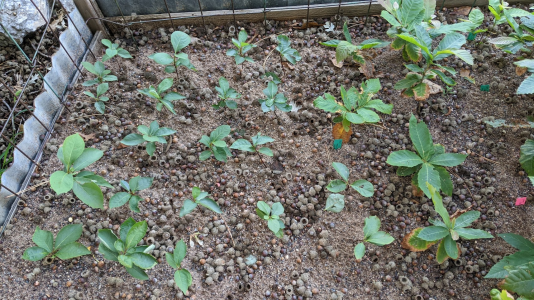@yoderjac et al,
Property where the trees will reside is in Zone 5a, I live south of the property in Zone 6a so the trees will get outside and begin hardening up sooner than they would up at the property. I have an enclosed trailer to transport them north when the weather warms up at the property. My dad lives near the property and is able to water and tend to the seedlings on a weekly basis during the growing season. My dad and I were able to grow out and plant 20 chestnut and red oak trees using more traditional growing methods outside in 1-gal black fabric bags. After reading about everyone's experiences and now attempting to capitalize on the great advice, we want to up our seedling numbers to 50 3-gal planted next year. We plan to start with with 200 18s, culling to 100 1-gal RM, and 50 3-gal RM. I would like to transplant the 50 culled 1-gal seedlings into 50 3-gal black fiber bags and sell them to help recover some of the initial start up cost of buying all the RM trays and pots.
Are the Express 18 w/Shuttle trays worth the extra expense over the standard 18 tray or 18 tray pull-apart? The trays will be used for no more than five seasons.
Are the RBII 1-gal (RB1) (216 cubic in) worth the extra expense over the original RMI-1R 1-gal (190 cubic in)? The price is nearly double for 10% more cubic space. Pots both 1-gal and 3-gal will be used for no more than five seasons.
Are the RBII 3-gal (RB3) (864 cubic in) worth the extra expense over the original RMI-3 3-gal (600 cubic in)? Again, the price is nearly double, BUT there is significantly more cubic space, 30%, and there is likely benefit to the flat bottom for the entire diameter of the pot when it comes to transplanting them at their final destination.
I will begin propagation inside in my basement using a similar table, fan, humidification, and shop light set up that has been shared with the group before.
the seeds will be cold stratified and acclimated to indoor ambient temperature at the first of the year. Seeds will spend 12 to 16 weeks in 18s before being transplanted into TBD 1-gal in April.
The seedlings will spend 12 to 16 weeks in the 1-gal before being transplanted into TBD 3-gal in August.
The seedlings will spend the rest of the growing season until they go dormant in the 3-gal before being transplanted in their final destination.
Has anyone transplanted seedlings into 5-gal and then grow them out until the following fall to have more influence on the seedlings for two growing seasons or could the seedlings root ball be constricted by a 5-gal in the second season and transplanting in final destination would need to come sooner than dormancy?
White oaks send out radicals in fall before winter, of course, so I will get them in the TBD 18 trays as soon as possible. How long can I keep them inside in the basement before I should force them to go dormant in my garage? I assume that I can't expect the white oaks to just send out a radical, establish a fall root system and then go right into sprouting a stem and leaves. Or should I start them in my garage and allow them protection from extreme weather and naturally go dormant when the weather turns. I would then bring them in after a dormancy period and allow them to begin growing inside alongside the seeds that required cold stratification.




